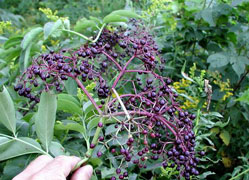


Home
Flowers &
Indoor Plants
Fruits & Nuts
Ornamentals
Vegetables
Special Topics
Resources
Glossary

|
Elderberry Sambucus nigra (sam-bew-cus nye-grah)   Click on thumbnails for larger image. |
 |
What about it? Elderberries are deciduous shrubs or small trees. The elderberry genus includes at least eight species native to North America. American Indians and early settlers made considerable use of the abundant fruit from wild species for beverages, preserves, and even for dye. What is it used for? In times past, tannin in the bark and roots of elderberry was used in tanning leather. Leaves, flowers, and fruit provided dyes for many Native American items, such as baskets. All parts of the elderberry have at some time been used in medicine. The hollow-stemmed wood of elderberry was used to make flutes. In fact, the scientific name is derived from the latin 'Sambuce' meaning flute. Currently, elderberry fruit is used in sauces, pies, tarts and wines. Where does it grow? How do we grow it? Elderberries are widely adapted, and will grow under a wide range of soil conditions, from very moist to fairly dry. They thrive on moist but well-drained fertile soils. Wet, poorly drained soils are not suitable. To yield tasty, full-sized fruits, provide elderberry plants with full sunlight. Plants need to be placed at least 56 feet apart. Plant 2 different varieties of elderberry for pollination. What are its primary problems? The most serious diseases affecting the elderberry are the tobacco and tomato ringspot viruses. Fungus diseases include stem and twig cankers. Powdery mildew can also infect leaves and berries in later summer and early fall. The most destructive insect is the elder shoot borer. Also damaging are the cecropia moth and birds feeding on ripe fruit. How do we harvest and store it? Harvest the berries when they are a rich purple-black color. They will be about a quarter to a half inch in diameter. They are very juicy so be careful in handling! Most home gardeners harvest the entire cyme, or fruiting structure, and pick off the individual berries later. Store in a cool spot and eat as soon as possible.
© Copyright, Department of Horticulture, Cornell University. |